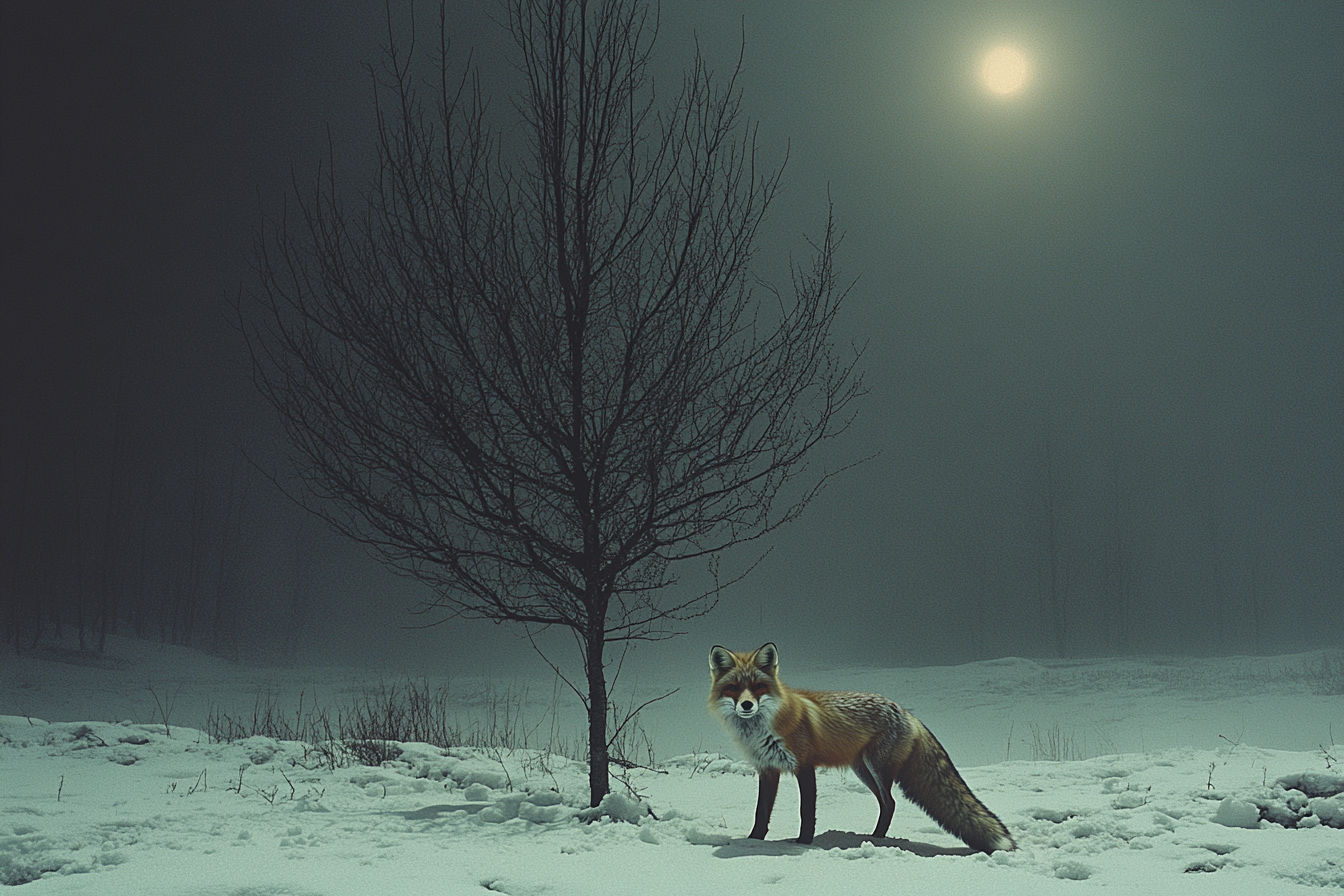When Do Foxes Come Out at Night? The Complete Guide to Britain’s Most Cunning Neighbour
Curious about when foxes start their nightly activities? Discover the typical times they emerge, and how factors like season, moonlight, and human activity influence their behaviour.

This post may contain affiliate links. If you make a purchase through these links, we may earn a commission at no additional cost to you.
It’s a familiar scene for many of us across Britain. You’re taking the bins out late one evening, or perhaps you’re woken by a strange noise in the garden. You peek through the curtains, and there it is: a flash of russet fur, a bushy tail, and a pair of bright, intelligent eyes. The red fox. For a moment, this wild creature is a part of your world, a silent, fleeting visitor under the glow of a streetlamp. Then, just as quickly, it’s gone, melting back into the shadows.
Foxes are one of Britain’s most iconic and adaptable mammals. They’re a common sight from the rolling hills of the Cotswolds to the bustling backstreets of London. But despite seeing them so often, how much do we really know about their nightly routines? We think of them as creatures of the night, but what does that actually mean? When do they wake up? What are they doing all night long? And why do they seem to be everywhere these days?
This guide is here to answer all those questions and more. We’re going to dive deep into the secret life of the urban and rural fox. Think of it as a backstage pass to one of nature’s most fascinating performances, happening right on our doorsteps every single night. We’ll explore why they prefer the darkness, what they get up to while we’re all tucked up in bed, and how their behaviour changes with the seasons. We’ll also bust a few myths and give you some practical tips for living alongside them. So, grab a cuppa, get comfortable, and let’s uncover the truth about when, and why, foxes come out at night.
Is the Fox Truly Nocturnal? Unpacking the Jargon
Before we get stuck in, let’s clear something up. We often hear the word nocturnal used to describe foxes, and while it’s not wrong, it doesn’t quite tell the whole story.
- Nocturnal animals are most active during the night. Think of badgers, hedgehogs, and most bats. They do their hunting, foraging, and socialising when it’s dark.
- Diurnal animals are the opposite – they’re active during the day. Humans, squirrels, and most garden birds fall into this category.
- Crepuscular is the really interesting one. This term describes animals that are most active during the twilight hours of dawn and dusk.
So, where does our friend the fox fit in? Technically, foxes are crepuscular. Their activity levels peak at dawn and dusk. This is the sweet spot for them. The light is low, making it harder for them to be seen by predators (or people), but there’s still just enough light for them to hunt effectively. It’s the perfect compromise.
However, especially in our busy towns and cities, foxes have learned to shift their schedules. To avoid the noise and chaos of human activity – rush hour traffic, school runs, people walking their dogs – they’ve become much more nocturnal. They’ve adapted their natural body clock to fit in with ours. By waiting until the world goes quiet, they get undisturbed access to our gardens, parks, and bins. It’s a brilliant example of how clever and adaptable these animals are. So, while their roots are in the twilight, for all intents and purposes, the modern British fox is a creature of the night.
The Fox’s Daily Timetable: A Night in the Life
A fox’s night isn’t just a random wander. It’s a structured, purposeful routine driven by instinct, hunger, and the need to stay safe. Let’s break down what a typical 24 hours looks like for an urban fox.
Late Afternoon to Dusk: The Waking Hour
As the sun begins to dip and the sky turns a soft orange, the fox’s day begins. Deep within its ‘earth’ (the name for a fox’s den), which could be under a garden shed, in a railway embankment, or within a patch of dense brambles, the fox starts to stir.
The first order of business is usually a good stretch and a yawn, just like us. You might see them emerge from their den, blinking in the fading light. This initial period is all about grooming – licking their fur clean and making sure they’re in top condition for the night ahead. They’ll often spend time socialising with their family members (if they have a mate or cubs) with gentle nuzzles and whines. This is a quiet, calm start to their busy ‘day’.
Dusk to Midnight: The Main Event – Foraging and Hunting
This is primetime for a fox. With the cover of darkness, they set out on their nightly patrol. A fox’s territory isn’t just a random patch of land; it’s a well-defined area that they know like the back of their hand. They patrol the same routes night after night, using scent markings (urine and faeces) to leave messages for other foxes, a bit like a community noticeboard saying, “This patch is taken.”
The main goal of this period is to find food. What’s on the menu depends on the season and location.
- In the countryside, foxes are skilled hunters. Their diet consists mainly of rabbits, rodents like voles and mice, birds, and even insects like beetles and earthworms. They have incredible hearing and can pinpoint the faintest rustle of a mouse in the undergrowth before pouncing with deadly accuracy.
- In our towns and cities, the menu is a bit different. While they still hunt rats and pigeons, urban foxes are master scavengers. This is when they’ll check for overflowing bins, investigate compost heaps, and hoover up any food that’s been dropped or left out for other animals, like bird feed or pet food. They’re not fussy eaters. They’ll happily munch on discarded pizza crusts, leftover curry, fallen fruit from garden trees, and tasty insects they find under logs. This is their version of a takeaway.
This period is their busiest. They can cover several miles within their territory, trotting along garden fences, slipping through hedges, and crossing roads with caution.
Midnight to Pre-Dawn: Socialising and Squabbling
The middle of the night is often a time for social activity. This is when you’re most likely to hear the eerie, blood-curdling screams of a vixen (female fox) or the sharp ‘hup-hup-hup’ bark of a dog fox (male).
People often mistake these sounds for an animal in distress, but it’s usually just foxes communicating. These calls are most common during the mating season in the depths of winter (December to February), but they can be heard all year round. It’s their way of locating each other, defending their territory from rivals, or warning off intruders. Think of it as their version of shouting across the street to a neighbour.
Younger foxes might also use this time for play-fighting, chasing each other and honing the skills they’ll need as adults. It’s a crucial part of their development and strengthens family bonds.
Dawn: The Final Foray and the Journey Home
As the first hint of light appears and the dawn chorus of birds begins, the fox knows its time is almost up. This is its last chance to find a morsel of food before the human world wakes up. They might make one final sweep of their favourite foraging spots.
As cars start to appear on the roads and people begin their morning routines, the fox will head for home. They retrace their steps back to the safety and seclusion of their earth. There, they will curl up and spend the daylight hours sleeping, safely hidden away from any potential dangers. The performance is over, at least until dusk falls again.
How the Seasons Change a Fox’s Nightlife
A fox’s routine isn’t set in stone. It’s a flexible schedule that adapts to the changing seasons, driven by two key things: the availability of food and the demands of raising a family.
Spring (March – May): A Time for Family
Spring is a hugely important time in the fox world. Vixens give birth to their cubs in the safety of the earth, usually in March. For the first few weeks, she stays underground with them while the dog fox takes on the role of provider. His nightly forays become more urgent and focused. He has to find enough food to feed himself and his partner.
As the cubs get a bit older, the vixen will also start making short trips out at night to hunt. This means you’re likely to see more fox activity in spring, as both parents work tirelessly to feed their hungry, growing family. In late April and May, if you’re very quiet and lucky, you might even catch a glimpse of the cubs themselves, playing near the entrance of the earth at dusk or dawn. They are incredibly playful and curious, and watching them is a real treat.
Summer (June – August): Teaching the Kids the Ropes
By summer, the cubs are much bigger and are starting to learn how to fend for themselves. The nights are short, so the adults have less time under the cover of darkness to find food for everyone. This can make them bolder. You might see them out and about earlier in the evening or later in the morning.
The parents will start taking the cubs on short foraging trips, teaching them how to hunt and where to find the best food sources. This is a noisy time! The cubs are still learning the rules of fox etiquette, and there can be a lot of yapping, whining, and playful scrapping. Natural food is abundant in summer – plenty of young rabbits, insects, and berries – which helps ease the pressure on the parents.
Autumn (September – November): Time to Move Out
Autumn is a season of change. The cubs from the spring are now almost fully grown. It’s time for them to leave their parents’ territory and find a patch of their own. This ‘dispersal’ period means there are a lot of young, inexperienced foxes wandering around.
These teenage foxes can be less cautious than the adults and might turn up in unexpected places as they try to navigate the world. They need to establish their own territory before winter sets in. This can lead to more territorial disputes and an increase in those dramatic-sounding barks and screams at night as boundaries are challenged and defended.
Winter (December – February): The Season of Love
Winter is mating season. The nights are long and cold, and the primary focus for foxes is finding a mate and securing their territory. This is when you will hear the most vocal activity. The vixen’s piercing scream is her way of signalling that she is ready to mate, and the dog foxes will respond with their sharp, barking calls.
Food can be scarcer in winter. The ground is hard, making it difficult to dig for worms and beetles, and many small mammals are hibernating or less active. This can make foxes more daring in their search for food. They might be more willing to come closer to houses or venture out during the day if they are particularly hungry. A fox seen in the snow is a truly beautiful sight, its red coat standing out starkly against the white.
The Urban Fox: A Modern Success Story
It’s impossible to talk about foxes in Britain without talking about the urban fox. It’s a relatively new phenomenon. Foxes only started moving into our cities in large numbers after the Second World War. They found that our suburbs offered a perfect habitat: plenty of places to shelter (like sheds, railway lines, and overgrown gardens) and an endless supply of food.
Life in the city has changed the fox. Here’s how:
- They are bolder: Urban foxes are used to people. They’ve learned that we don’t generally pose a threat, so they are often much less timid than their country cousins. Some will happily trot down a pavement on the other side of the road without a second glance.
- Their territories are smaller: Food is so readily available in cities that a fox doesn’t need a huge area to survive. An urban fox’s territory might be just a fraction of the size of a rural fox’s. This is why our towns and cities can support such a high density of foxes.
- Their diet is more varied: The urban fox is the ultimate opportunist. From half-eaten kebabs to bird seed and windfall apples, they’ll eat almost anything. This adaptable diet is the key to their success.
- They are more nocturnal: As we discussed earlier, city life has pushed foxes to become more strictly active at night to avoid the daytime hustle and bustle.
The rise of the urban fox has been a remarkable success story, a testament to their intelligence and adaptability. They have learned to live alongside us, carving out a life in the shadows of our own.
Common Myths and Misconceptions About Foxes
Foxes are often misunderstood, and there are a lot of myths out there. Let’s bust a few of the most common ones.
Myth 1: Urban fox numbers are out of control.
Reality: This is a common belief, but studies show that the urban fox population is actually quite stable. A territory will only support a certain number of foxes. If numbers grow, the food supply runs low, and the population naturally corrects itself. The number of foxes you see is a reflection of how much food is available.
Myth 2: Foxes are a major threat to cats and dogs.
Reality: It is extremely rare for a fox to attack a cat or a dog. A fully grown cat is a formidable opponent, and a fox will almost always back down rather than risk injury. They are scavengers and hunters of small prey, not fighters. Most of the time, foxes and cats simply ignore each other or maintain a respectful distance. Any confrontation is usually the result of a cat defending its territory from a fox that has wandered in by mistake.
Myth 3: Foxes raid bins because they are starving.
Reality: A fox raiding a bin is not a sign of desperation; it’s a sign of intelligence. They have learned that bins are an easy and reliable source of high-calorie food. It’s much easier to tip over a bin bag to get at some leftover chicken than it is to spend hours hunting for a mouse. They are simply taking the easiest option available.
Myth 4: Foxes carry diseases that are dangerous to humans.
Reality: Foxes can carry diseases, but the risk to humans is incredibly low. Mange is a skin condition caused by mites that can make foxes look very unwell, but it cannot be passed to humans. The parasite Toxocara canis can be found in their faeces, but the risk of transmission is much higher from domestic dogs. Basic hygiene, like washing your hands after gardening, is enough to eliminate any tiny risk.
Living Peacefully with Our Foxy Neighbours
For the most part, foxes are harmless visitors that can bring a lot of joy. Watching them go about their business can be a real privilege. However, sometimes their behaviour can cause minor problems, like digging up flowerbeds or leaving a mess. The good news is that there are simple, humane ways to discourage them if they become a nuisance.
The key is to make your garden less appealing to them.
- Secure your rubbish: This is the most important step. Make sure your bins are securely sealed. If you use bin bags, only put them out on the morning of collection. Don’t leave any bags of rubbish lying around.
- Don’t leave food out: Avoid feeding foxes directly, as this encourages them to become too bold. Don’t leave pet food or bird food on the ground overnight. Tidy up fallen fruit from trees.
- Use humane deterrents: There are various non-harmful deterrents available. Scent-based repellents can be effective, as foxes have a very strong sense of smell. You can buy these from garden centres. Water-squirting devices triggered by motion sensors can also work well to startle them without causing any harm.
- Block access to shelters: If you don’t want a fox setting up home under your shed or decking, you can block the access points with sturdy wire mesh. Make sure you do this in late autumn, after the cubs have left, to avoid trapping any animals inside.
Remember, we share our environment with these animals. A little bit of understanding and a few sensible precautions are usually all that’s needed to ensure we can live together happily.
Conclusion: The Enduring Magic of the Fox at Night
The red fox is a survivor. It has adapted to a world that has changed dramatically around it, finding a way to thrive in the busiest of cities and the quietest of countrysides. Their nightly patrols are a hidden, parallel world that exists all around us.
So, the next time you see that flash of red fur in the twilight, or hear a strange bark in the dead of night, you’ll know a bit more about what’s going on. You’ll know that it’s not just a random wander, but a small part of a complex and fascinating life. You’ll know that they are busy foraging, patrolling, socialising, and raising their families, all under the protective cloak of darkness.
They are a reminder that even in our modern, built-up world, wildness is never far away. It’s trotting silently down our streets and sleeping under our sheds. And that’s a pretty magical thing.
Further Reading
For those interested in learning more about foxes and other British wildlife, here are some excellent resources from highly respected organisations:
- The Wildlife Trusts: A fantastic source of information on all UK wildlife, with local branches across the country. https://www.wildlifetrusts.org/wildlife-explorer/mammals/red-fox
- RSPCA (Royal Society for the Prevention of Cruelty to Animals): Offers practical advice on living with foxes and what to do if you find an injured or sick animal. https://www.rspca.org.uk/adviceandwelfare/wildlife/foxes
- The Fox Project: A charity dedicated to protecting and preserving the red fox, with a wealth of detailed information and advice. https://foxproject.org.uk/
- Woodland Trust: Provides information on foxes in their natural woodland habitats and their role in the ecosystem. https://www.woodlandtrust.org.uk/trees-woods-and-wildlife/animals/mammals/red-fox/






